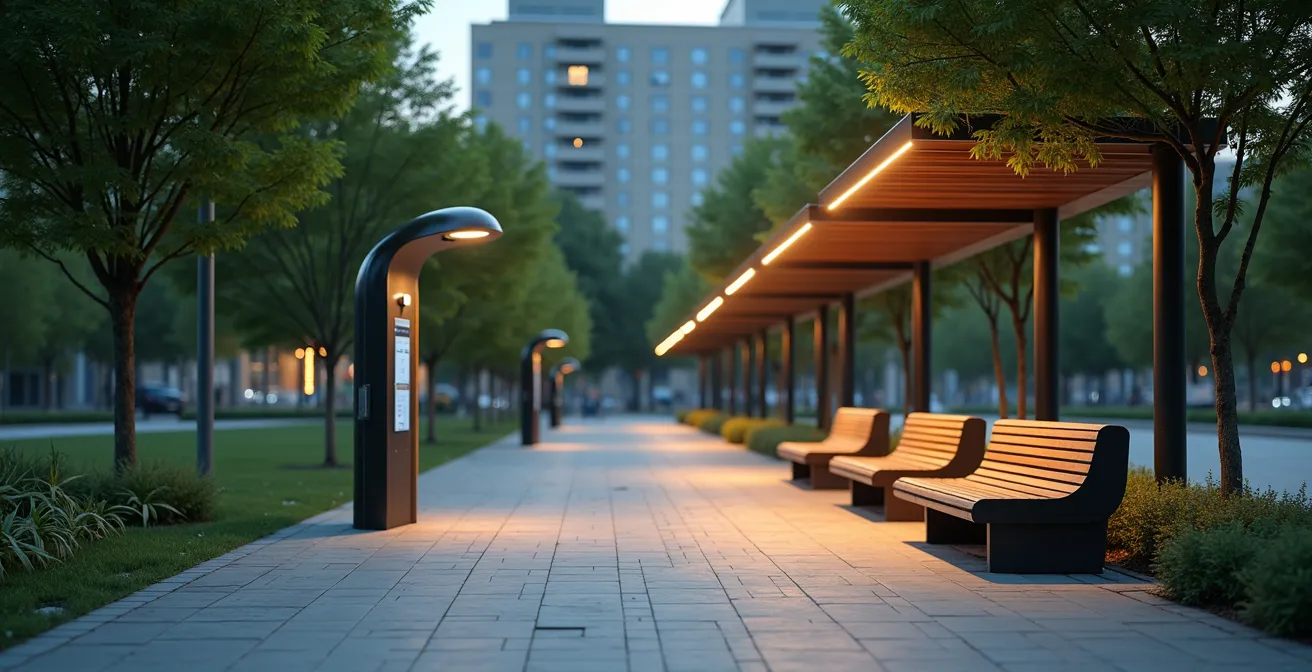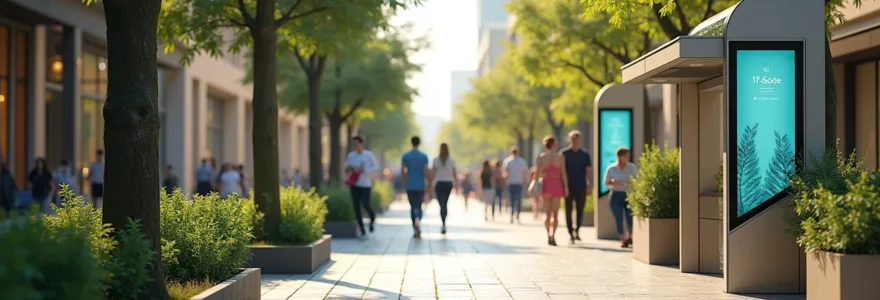Street furniture is no longer a passive collection of benches, bins, and lights. It is undergoing a profound transformation, evolving from static objects into an active, intelligent network that is fundamentally reshaping the urban experience. Beyond the obvious conveniences of Wi-Fi hotspots and charging ports, this new generation of urban infrastructure is the silent architect of our cities’ future—enhancing public safety, fostering community identity, and building economic and environmental resilience. This shift isn’t just about adding technology; it’s about redesigning the relationship between citizens and their public spaces.
As cities grow denser, the public realm becomes more critical than ever. Innovative street furniture acts as a catalyst, turning mundane sidewalks and parks into dynamic, responsive environments. It addresses core urban challenges by embedding functionality directly into the cityscape, making our communities safer, more connected, and more sustainable. The true revolution lies in how these elements work together to create a cohesive, human-centric urban fabric.
The Urban Future in Focus
- Beyond Convenience: Discover how smart furniture offers more than just connectivity, actively improving safety and community well-being.
- Data-Driven Decisions: Learn how integrated sensors provide valuable insights for better urban planning and resource management.
- Identity and Investment: Understand the connection between thoughtful streetscape design, civic pride, and economic vitality.
- Sustainable Foundations: Explore how eco-friendly materials and resilient design are preparing cities for future challenges.
Bridging innovation and implementation: The crucial role of expert street furniture providers
The leap from a visionary smart city concept to a functional, on-the-ground reality is complex. Turning ambitious plans into tangible assets requires navigating intricate procurement processes and sourcing highly specialized solutions. This is where expert providers of specialized street furniture solutions, like procity.eu, become indispensable partners for municipalities. Their role extends far beyond simple manufacturing; they are translators of urban ambition, ensuring that cutting-edge ideas are grounded in practical, durable, and effective applications.
These providers bring deep expertise in material science, helping cities select options that balance aesthetics with durability and long-term value. Their understanding of lifecycle cost analysis ensures that an investment made today remains viable and cost-effective for decades. Furthermore, as street furniture becomes increasingly intelligent, these specialists are crucial for ensuring the effective and ethical integration of smart technologies, from sensors to communication modules. The growing smart furniture market, with an expected 6.45% CAGR growth through 2030, underscores the rising demand for this specialized knowledge.
Expert providers translate complex urban visions into tangible, high-performance street furniture realities through mastery of materials and technology.
– Urban Design Specialist, TechSci Research
A structured approach to procurement is essential for success. Municipalities must clearly define their needs, from technological requirements to community goals, before engaging with providers. This clarity allows for a more effective partnership in creating urban spaces that are both innovative and truly functional, as one industry insider notes, the goal is to blend design with functionality to create solutions “tailored for unique urban challenges.”
Key Steps for Specialized Furniture Procurement
- Define urban needs and tech requirements.
- Assess provider expertise in materials and lifecycle costs.
- Ensure integration with ethical smart tech.
- Validate prototypes with stakeholders before full rollout.
Beyond aesthetics: Measuring the tangible impact of smart street furniture
The value of innovative street furniture extends far beyond visual appeal; its true impact can be measured in tangible improvements to urban life. By integrating smart technologies, cities can achieve quantifiable gains in public safety, community engagement, and economic vitality. These are not abstract benefits but concrete outcomes that directly enhance the quality of life for residents and visitors alike.
What Are the Tangible Benefits of Smart Street Furniture?
Beyond looks, it measurably improves public safety through smart lighting, boosts local economies by increasing foot traffic, and strengthens community bonds by creating engaging public spaces.
One of the most significant impacts is on public safety. Intelligent lighting systems, for example, can adapt to real-time conditions, brightening in response to pedestrian presence and helping to deter crime. Studies have shown this can lead to an up to 25% reduction in crime rates with smart lighting. Economically, well-designed streetscapes encourage footfall, creating vibrant commercial areas that support local businesses. The data generated by smart furniture—such as pedestrian flow and dwell times—also provides invaluable insights for urban planners, enabling them to allocate resources more effectively and make informed decisions that are revolutionizing urban mobility and transportation.
The following table illustrates the direct correlation between smart street furniture investments and their measurable benefits across key urban domains.
| Benefit Category | Indicator | Impact |
|---|---|---|
| Public Safety | Crime Rate Reduction | Up to 25% decrease with intelligent lighting |
| Economic | Increased Foot Traffic | Boost local business revenue |
| Community | Engagement Level | Enhanced social cohesion and wellbeing |
Introducing thoughtfully designed furniture can also significantly enhance community well-being by reducing stress and fostering social interaction. It creates inclusive spaces that support vulnerable groups, such as the elderly and children, making public areas more accessible and welcoming for everyone.
This visual concept captures the synergy between safety, economy, and community fostered by smart street furniture.

Ultimately, by serving multiple functions, smart furniture transforms public spaces from passive thoroughfares into active hubs of community life, demonstrating a clear return on investment that goes far beyond its initial cost.
Cultivating urban identity: The psychological and economic value of thoughtful streetscapes
Street furniture is a powerful tool for shaping a city’s identity. Far more than just functional objects, benches, planters, and shelters act as a collective visual language that communicates the character and values of a place. When designed with intention and a connection to local culture, street furniture fosters a deep sense of civic pride and belonging among residents, transforming anonymous spaces into cherished community hubs.
Well-designed street furniture fosters civic pride, belonging, and is a catalyst for vibrant, walkable urban centers.
– Dr. Helena Garcia, Urban Influence Magazine
This investment in quality of place yields significant economic returns. Vibrant, walkable, and attractive urban centers draw more visitors, encourage longer stays, and boost local commerce. Municipalities that prioritize innovative, high-quality street furniture often see a positive ripple effect on property values and private investment. The subtle influence of a well-crafted streetscape on the experiences of both residents and tourists can be a deciding factor in a city’s economic competitiveness.
Revitalizing Public Spaces Through Innovative Furniture in Manchester
A project incorporating bespoke street furniture resulted in increased local business investment, stronger community engagement, and higher visitor satisfaction.
The psychological and economic benefits are deeply intertwined, as summarized below.
| Aspect | Benefit | Effect |
|---|---|---|
| Pride & Belonging | Civic Identity | Stronger community bonds |
| Economic Return | Investment & Foot Traffic | Boosts local economy |
| Urban Experience | Walkability & Vibrancy | More attractive urban centers |
To successfully cultivate this urban identity, cities should adopt a strategic approach that goes beyond off-the-shelf solutions.
Steps to Enhance Urban Identity via Street Furniture
- Prioritize culturally relevant design elements.
- Engage local communities in co-creation.
- Use materials that reflect regional identity.
- Incorporate interactive and social features.
Key Takeaways
- Expert providers are essential for translating complex urban visions into practical, high-performance street furniture realities.
- Smart street furniture delivers measurable impacts on public safety, economic activity, and community engagement.
- Thoughtful streetscape design is a key driver of civic pride, urban identity, and economic return on investment.
- The future of urban design lies in resilient, sustainable furniture that is both technologically advanced and ethically grounded.
Designing for tomorrow: Resilience, sustainability, and the future of urban streetscapes
As cities face mounting pressures from climate change and public health challenges, the role of street furniture is evolving to become a key component of civic resilience strategies. Furniture designed with sustainable materials and circular economy principles is no longer a niche trend but a core requirement for future-ready urban development. This forward-looking approach ensures that our public spaces are not only beautiful and functional but also robust and adaptable.
The market is responding to this demand, with a projected 13.2% CAGR forecast from 2025 to 2032 for smart street furniture. This growth reflects a broader evolution of “smart” beyond simple connectivity. The next generation of urban furniture will be truly adaptive, using sensors and data to respond to environmental conditions in real-time—from adjusting lighting levels to managing stormwater. Advanced materials like WPVC, which combines wood and plastic, offer durability while supporting sustainability goals.
However, this technological integration brings a critical responsibility. As our street furniture becomes a network of data collection points, establishing strong ethical frameworks is paramount. Ensuring data privacy, robust cybersecurity, and equitable access to these new amenities are non-negotiable principles. True urban innovation requires a commitment to transparency and designing with privacy in mind to build and maintain public trust. For those looking to navigate these changes, it’s wise to explore tips for successful business integration of these new technologies.
Frequently Asked Questions on Urban Development
What exactly is “smart” street furniture?
Smart street furniture refers to common public objects like benches, bins, and lights that have been enhanced with technology. This can include features like Wi-Fi hotspots, device charging ports, environmental sensors (for air quality or noise levels), and intelligent lighting that adapts to its surroundings.
How does street furniture contribute to a city’s economic health?
Well-designed street furniture enhances the appeal and functionality of public spaces, which encourages higher foot traffic. This directly benefits local businesses by attracting more customers. It also contributes to higher property values and can attract tourism and investment by making a city a more desirable place to live and visit.
Are there privacy concerns with data-collecting street furniture?
Yes, privacy is a significant consideration. Smart furniture can collect data on public space usage, which is valuable for urban planning but must be managed responsibly. Cities and providers must implement strong ethical frameworks, ensure data is anonymized, maintain cybersecurity, and be transparent with the public about what data is collected and how it is used.
